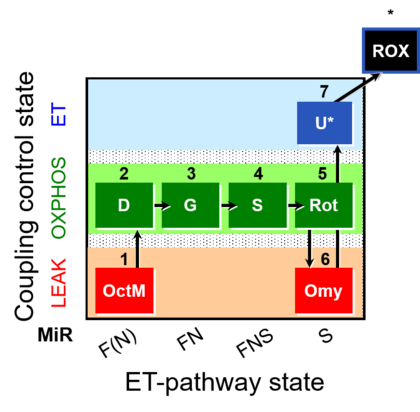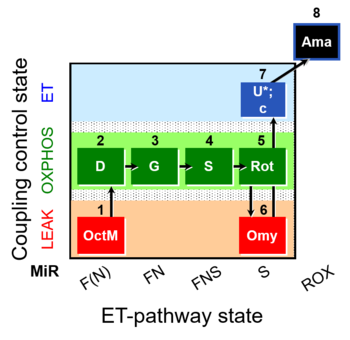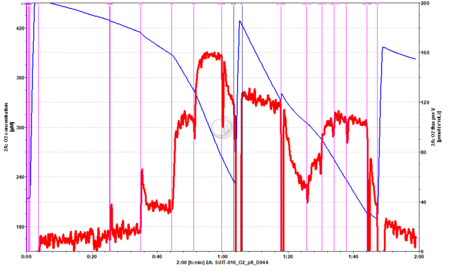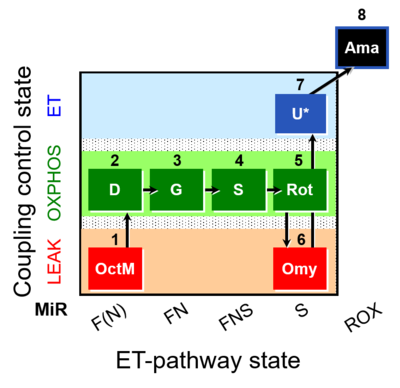Difference between revisions of "SUIT-016"
From Bioblast
Beno Marija (talk | contribs) |
Beno Marija (talk | contribs) |
||
| (44 intermediate revisions by 9 users not shown) | |||
| Line 1: | Line 1: | ||
{{MitoPedia | {{MitoPedia | ||
|abbr= | |abbr=F+G+S+Rot_OXPHOS+Omy | ||
|description=[[File:1OctM;2D;3G;4S;5Rot;6Omy;7U-. | |description=[[File:1OctM;2D;3G;4S;5Rot;6Omy;7U-.png|420px]] | ||
|info='''A | |info='''A: [[Fatty_acid_oxidation_pathway_control_state|F-pathway]] in [[LEAK respiration#The_LEAK_state |LEAK state]] and [[Oxidative phosphorylation|OXPHOS state]]''' | ||
}} | }} | ||
::: '''[[SUIT protocol pattern]]:''' 1OctM;2D;3G;4S;5Rot;6Omy;7U- | |||
SUIT-016 gives information on [[Fatty_acid_oxidation_pathway_control_state|F-pathway]] in [[LEAK respiration#The_LEAK_state |LEAK state]] and [[Oxidative phosphorylation|OXPHOS state]] avoiding FAO overestimation in the presence of [[Anaplerosis|anaplerotic]] pathways. In addition, the pathway control of [[FN]] and [[FNS]] in [[Oxidative phosphorylation|OXPHOS state]] and of [[S]] in [[LEAK respiration#The_LEAK_state |LEAK state]] and [[ET capacity| ET state]] is evaluated. | |||
::: '''[[ | |||
__TOC__ | __TOC__ | ||
Communicated by [[Doerrier C]], [[Huete-Ortega M]], [[Cardoso LHD]] and [[Gnaiger E]] (last update 2019-06-05) | |||
== Specific SUIT protocols == | |||
[[File:1OctM;2D;3G;4S;5Rot;6Omy;7U;7c-8Ama.jpg|350px]][[File:SUIT-016 O2 pfi D044 traces.png|450px]] | |||
::::* [[SUIT-016 O2 pfi D044]] for permeabilized fibers | |||
{{Template:SUIT-016}} | |||
== Strengths and limitations == | |||
:::+ This protocol provides information on FAO capacity in the absence of other potentially interfering pathways both in LEAK and OXPHOS coupling-control states. | |||
:::+ FNS OXPHOS capacity comprises the most important pathways in many cell types and thus provides a physiologically relevant estimate of maximum mitochondrial respiratory capacity. | |||
:::+ FNS ET capacity is a good estimate of overall ET capacity in many cell types. | |||
:::+ This is a good protocol to analyse coupling control at S-pathway, which is an advantage compared to [[SUIT-015]] and [[SUIT-017]]. | |||
:::+ Glutamate is easier to prepare compared to pyruvate. | |||
:::- In some tissues GM is not sufficient to fully support N-pathway capacity | |||
:::- SRot(E) may be underestimated if S is not saturating. | |||
:::- SRot(E) may be underestimated in the presence of Omy in some tissues and cell types | |||
:::- CIV activity is not measured, to save experimental time. | |||
:::* It is possible to add cytochrome ''c'' in different steps: | |||
:::::::* (2c), when cytochrome ''c'' is added after 2D, it allows to compare all steps in OXPHOS even if there is damage of the mitochondrial outer membrane. This approach can be chosen when the cytochrome ''c'' effect is not an exclusion criteria. | |||
:::::::* (3c) when cytochrome ''c'' is added after 3G, due to the higher flux, it is easier to evaluate whether there is an increase in respiration indicating damages in the mitochondrial outer membrane. However, if there is a strong cytochrome ''c'' effect, it is not possible to compare OctM<sub>''P''</sub> with the next steps in OXPHOS. | |||
:::::::* (7c) when cytochrome ''c'' is added after 7U: if there is no cytochrome c effect, it indicates that even after the whole lenght of the protocol, there were no damages to the mitochondrial outer membrane. This approach can be used as an exclusion criteria for samples that normally do not present mitochondrial outer membrane damage after the sample preparation, e.g. human permeabilized muscle fibers. | |||
== Compare SUIT protocols == | |||
::::* [[SUIT-017]] | |||
::::* [[SUIT-015]] | |||
== References == | == References == | ||
{{#ask:[[Category:Publications]] [[Additional label:: | {{#ask:[[Category:Publications]] [[Instrument and method::O2k-Protocol]] [[Additional label::SUIT-016]] | ||
|?Was published in year=Year | |?Was published in year=Year | ||
|?Has title=Reference | |?Has title=Reference | ||
| Line 24: | Line 49: | ||
}} | }} | ||
{{MitoPedia concepts | |||
|mitopedia concept=MiP concept, SUIT protocol, Recommended | |||
}} | |||
{{MitoPedia methods | |||
|mitopedia method=Respirometry | |||
{ | }} | ||
| | |||
| | |||
Latest revision as of 15:19, 8 June 2020
Description
Abbreviation: F+G+S+Rot_OXPHOS+Omy
Reference: A: F-pathway in LEAK state and OXPHOS state
- SUIT protocol pattern: 1OctM;2D;3G;4S;5Rot;6Omy;7U-
SUIT-016 gives information on F-pathway in LEAK state and OXPHOS state avoiding FAO overestimation in the presence of anaplerotic pathways. In addition, the pathway control of FN and FNS in OXPHOS state and of S in LEAK state and ET state is evaluated.
Communicated by Doerrier C, Huete-Ortega M, Cardoso LHD and Gnaiger E (last update 2019-06-05)
Specific SUIT protocols
- SUIT-016 O2 pfi D044 for permeabilized fibers
Steps and respiratory states
| Step | State | Pathway | Q-junction | Comment - Events (E) and Marks (M) |
|---|---|---|---|---|
| 1OctM | OctML(n) | F(N) | CETF | 1OctM
|
| 2D | OctMP | F(N) | CETF | 1OctM;2D
|
| 3G | OctGMP | FN | CETF&I | 1OctM;2D;3G
|
| 4S | OctGMSP | FNS | CETF&CI&II | 1OctM;2D;3G;4S
|
| 5Rot | SP | S | CII | 1OctM;2D;3G;4S;5Rot
|
| 6Omy | SL(Omy) | S | CII | 1OctM;2D;3G;4S;5Rot;6Omy
|
| 7U | SE | S | CII | 1OctM;2D;3G;4S;5Rot;6Omy;7U
|
| 8Ama | ROX | 1OctM;2D;3G;4S;5Rot;6Omy;7U;8Ama
|
| Step | Respiratory state | Pathway control | ET-Complex | Comment |
|---|---|---|---|---|
| ## AsTm | AsTmE | CIV | CIV | |
| ## Azd | CHB |
- Bioblast links: SUIT protocols - >>>>>>> - Click on [Expand] or [Collapse] - >>>>>>>
- Coupling control
- Pathway control
- Main fuel substrates
- » Glutamate, G
- » Glycerophosphate, Gp
- » Malate, M
- » Octanoylcarnitine, Oct
- » Pyruvate, P
- » Succinate, S
- Main fuel substrates
- Glossary
Strengths and limitations
- + This protocol provides information on FAO capacity in the absence of other potentially interfering pathways both in LEAK and OXPHOS coupling-control states.
- + FNS OXPHOS capacity comprises the most important pathways in many cell types and thus provides a physiologically relevant estimate of maximum mitochondrial respiratory capacity.
- + FNS ET capacity is a good estimate of overall ET capacity in many cell types.
- + This is a good protocol to analyse coupling control at S-pathway, which is an advantage compared to SUIT-015 and SUIT-017.
- + Glutamate is easier to prepare compared to pyruvate.
- - In some tissues GM is not sufficient to fully support N-pathway capacity
- - SRot(E) may be underestimated if S is not saturating.
- - SRot(E) may be underestimated in the presence of Omy in some tissues and cell types
- - CIV activity is not measured, to save experimental time.
- It is possible to add cytochrome c in different steps:
- (2c), when cytochrome c is added after 2D, it allows to compare all steps in OXPHOS even if there is damage of the mitochondrial outer membrane. This approach can be chosen when the cytochrome c effect is not an exclusion criteria.
- (3c) when cytochrome c is added after 3G, due to the higher flux, it is easier to evaluate whether there is an increase in respiration indicating damages in the mitochondrial outer membrane. However, if there is a strong cytochrome c effect, it is not possible to compare OctMP with the next steps in OXPHOS.
- (7c) when cytochrome c is added after 7U: if there is no cytochrome c effect, it indicates that even after the whole lenght of the protocol, there were no damages to the mitochondrial outer membrane. This approach can be used as an exclusion criteria for samples that normally do not present mitochondrial outer membrane damage after the sample preparation, e.g. human permeabilized muscle fibers.
Compare SUIT protocols
References
| Year | Reference | Organism | Tissue;cell | |
|---|---|---|---|---|
| Gnaiger 2015 Scand J Med Sci Sports | 2015 | Gnaiger E, Boushel R, Søndergaard H, Munch-Andersen T, Damsgaard R, Hagen C, Díez-Sánchez C, Ara I, Wright-Paradis C, Schrauwen P, Hesselink M, Calbet JAL, Christiansen M, Helge JW, Saltin B (2015) Mitochondrial coupling and capacity of oxidative phosphorylation in skeletal muscle of Inuit and caucasians in the arctic winter. https://doi.org/10.1111/sms.12612 | Human | Skeletal muscle |
MitoPedia concepts:
MiP concept,
SUIT protocol,
Recommended
MitoPedia methods:
Respirometry





